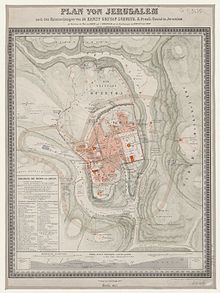Ernst Gustav Schultz
Ernst Gustav Schultz (born May 20, 1811 in Döbern , † October 22, 1851 in Jerusalem ) was a German Orient researcher and Prussian consul in Jerusalem.
His father was superintendent in Hirschfeld. Schultz attended high school in Elbing and from 1829 studied theology and then oriental studies at the University of Königsberg . From 1834 to 1838 he continued his studies in Paris with Antoine-Isaac Silvestre de Sacy , Étienne Marc Quatremère and Eugène Burnouf ; from 1836 he was tutor to Count Jaubert in Paris and, while studying, learned colloquial Arabic from an Egyptian. In 1838 he completed his habilitation in Königsberg, where he gave lectures on Arabic and Hebrew. He also gave private lessons and edited the three-volume anthology La France Contemporaine . In 1841 he traveled to London and Oxford to study Arabic manuscripts, visited Christian Karl Josias von Bunsen on the way back and was brought into the diplomatic service in Berlin by the Prussian Minister of Education, Friedrich Eichhorn . Before that he was supposed to succeed Peter von Bohlen at the chair for oriental studies in Königsberg. From 1842 he was Prussian Vice Consul for Syria and Palestine, based in Jerusalem . His historical and geographical studies there resulted in his Jerusalem book, published in 1845, which he wrote during a stay in Berlin (he also visited his homeland and Oxford and Cambridge). In Berlin he also met King Friedrich Wilhelm IV and Alexander von Humboldt .
In 1845 he was back in Jerusalem and was promoted to consul. He acquired the former American mission station as the seat of the consulate, which later became a pilgrimage and deaconess station. Not least thanks to his language skills, he had good contacts in Jerusalem and neighboring areas and in 1847 also temporarily took over the consulate general in Beirut . In the autumn of 1847 he traveled to Galilee . In 1848 he returned to Berlin (partly as a result of the revolutionary events, but he was also ill) and was there again scientifically active, among other things he worked on a map for Galilee, which remained unfinished. In 1850 he was back in Jerusalem, but soon became seriously ill (jaundice, “fever”, and he broke his leg when he fell from his horse) and died in October 1851 of the consequences. He was buried in the Zion Cemetery of the Evangelical Church in Jerusalem and the Anglican St. George's Cathedral on Mount Zion in Jerusalem.
Fonts
- Variae lectiones e codice ms. Parisiensi collectae ad Abulfaragii Babbaghae carmina a Philippo Wolffio edita. Hartung, 1838 ( digitized version )
- Jerusalem. A lecture. With a tarpaulin drawn by H. Kiepert . Simon Schropp & Co. , Berlin 1845 ( digitized version )
literature
- Friedrich Ratzel : Schultz, Ernst Gustav . In: Allgemeine Deutsche Biographie (ADB). Volume 32, Duncker & Humblot, Leipzig 1891, pp. 704 f.
- Philipp Wolff : Jerusalem, 1857, pp. 204–214
- Carl Zimmermann : Attempt to build the map of Galilee by Carl Zimmermann. Colonel aggr. the Gr. General staff. According to the research of the late Dr. Ernst Gustav Schulz, Royal Prussian Consul in Jerusalem . D. Reimer, Berlin 1861 ( digitized version )
- Carl Zimmermann: Geographical analysis of the attempt to build the map of Galilee along with the small maps of the Gilboa mountains, the Jafat rock and the Accon crusader stronghold. Mostly published after the research of the late Dr. Ernst August Schulz, formerly Royal. Preuss. Consul in Jerusalem . Dietrich Reimer, Berlin 1861 ( digitized version )
Web links
| personal data | |
|---|---|
| SURNAME | Schultz, Ernst Gustav |
| BRIEF DESCRIPTION | German oriental researcher and Prussian consul in Jerusalem |
| DATE OF BIRTH | May 20, 1811 |
| PLACE OF BIRTH | Döbern |
| DATE OF DEATH | October 22, 1851 |
| Place of death | Jerusalem |

